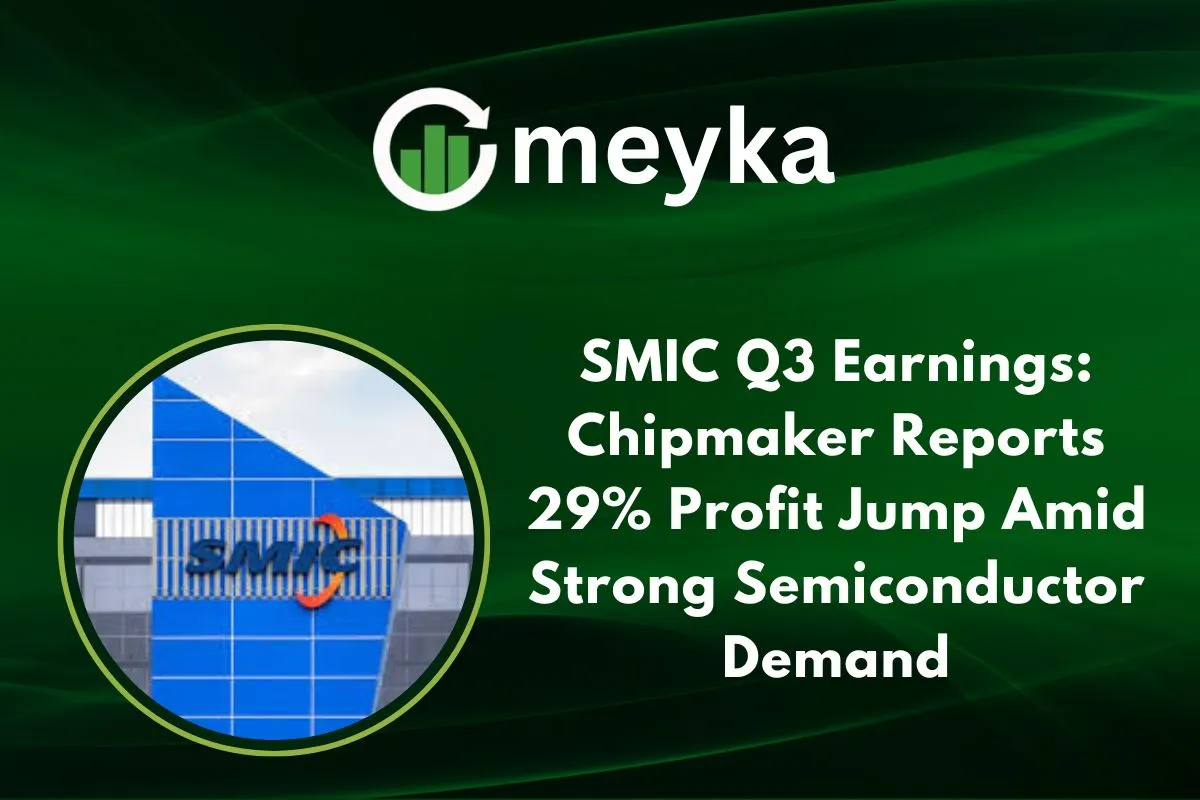SMIC Q3 Earnings: Chipmaker Reports 29% Profit Jump Amid Strong Semiconductor Demand
We just got the latest results for Semiconductor Manufacturing International Corporation (SMIC), and the numbers are eye-catching. The company posted a 28.9% year-on-year profit jump in the third quarter, reaching about US$191.75 million, beating analyst estimates.
Revenue also rose by roughly 9.7% to US$2.38 billion, topping forecasts of US$2.345 billion. We’ll walk you through what’s behind these results, what global trends are helping SMIC, the challenges it faces, and whether this momentum can continue. We aim to help you understand: what’s driving SMIC Q3 earnings, what they mean, and where the company might go next.
Q3 Financial Highlights
Let’s break down the key figures for SMIC’s Q3 performance:
- Net profit: US$191.75 million, up 28.9% year-on-year.
- Revenue: US$2.38 billion, up 9.7% compared to the same quarter last year.
- The revenue number beat analysts’ expectations (around US$2.345 billion) and the profit beat estimates (~US$178.88 million).
This shows SMIC is gaining ground, with stronger sales and higher profit growth.
We also note that the growth rate in revenue (about 9.7%) is smaller than the profit growth (~29%), indicating improved efficiency or better margins. However, SMIC did not publish full breakdowns publicly in all sources, so we maintain some caution.
What’s Driving SMIC’s Growth?
We can point to several reasons why SMIC Q3 earnings are strong:
- Surging demand for semiconductors globally. The chip industry is benefiting from AI, 5G, EVs, and data-centres. For example, a report says global semiconductor demand will grow strongly in 2025.
- China’s domestic push. SMIC, as China’s largest contract chipmaker, is positioned well in the local market, which is prioritising chip production and supply-chain independence.
- Legacy/mature-node chips. SMIC focuses more on older (but still vital) process technologies, which are seeing strong use in cars, power management, IoT, and industrial devices in China. This niche helps it avoid cut-throat competition for the bleeding-edge nodes.
- Geopolitical tailwinds. With export controls from the U.S. and others restricting some advanced chip tools, local Chinese firms may ramp production domestically and rely more on suppliers like SMIC. That may create extra demand.
Putting it together: the strong Q3 earnings reflect both a global demand up-cycle and a favourable domestic environment for SMIC.
Impact of Global Semiconductor Trends
We should widen the lens beyond SMIC to see how the wider chip industry is behaving, because SMIC doesn’t operate in a vacuum.
- The global semiconductor market is expected to grow as firms invest in AI, high-performance computing, data centres, and industrial electronics.
- In China specifically, the foundry (chip manufacturing) market is estimated at about US$14.85 billion in 2025 and expected to grow at around 12.4% CAGR through 2030.
- Mature‐node chips (such as 28 nm and above) are key in automotive, power electronics, and IoT segments, which are growing fast. The Chinese foundry market report notes that 28 nm held ~33.3% of the market in 2024.
- On the flip side, there are risks of oversupply, especially in mature nodes, and challenges in accessing cutting-edge tools due to export restrictions. SMIC itself flagged oversupply risk in mature nodes.
From SMIC’s vantage, the trend means more demand for its services, but also competition and cost pressures.
Expansion and Technological Advancements
We now look at how SMIC is trying to expand and upgrade its technology, and the obstacles.
- SMIC is increasing its fab capacity and targeting more volume in these high-demand mature nodes. While specifics of Q3 weren’t fully detailed in public sources, the broader industry context shows China is ramping up fab investment.
- On advanced nodes (7 nm and below), SMIC faces hurdles due to equipment access and yield maturity. Because of export controls, access to extreme ultraviolet (EUV) lithography and other advanced tools is limited.
- The technological gap is real: China is driving self-reliance in semiconductor production and AI hardware, but still lags global leaders in some respects.
So while SMIC’s Q3 earnings reflect current strength, the company’s ability to scale further into more advanced chips remains a longer-term story and a challenge.
Challenges and Risks
It wouldn’t be complete without discussing what could hold SMIC back.
- Export restrictions: SMIC is affected by U.S. and allied export controls on chip-making equipment and advanced node tools. This limits its ability to move quickly into leading-edge nodes.
- Overcapacity & margin pressure: The mature-node foundry market is becoming crowded; SMIC itself noted the risk of oversupply in mature nodes, which could squeeze prices and margins.
- Geopolitical risks: Increased trade tensions, sanctions, and supply-chain disruptions could impact SMIC’s access to tools, customers, and global markets.
- Demand shifts: Some end-markets like consumer electronics may soften, which could dampen demand for chips in certain nodes. The industry outlook notes this risk.
These risks mean we should view SMIC’s strong Q3 earnings with optimism but also healthy caution.
Market Reaction and Analyst Insights
How have markets and experts responded to SMIC’s Q3 performance?
- The profit beat and revenue beat triggered positive attention in the market. For instance, SMIC shares rose following the announcement.
- Analysts note that while the 29% profit growth is impressive, sustaining such growth may be harder given margin pressures and competition. Many emphasise that SMIC’s strong domestic positioning provides an edge.
- Looking ahead, the company provided guidance or expectation of moderate growth; many analysts model steady, not explosive, growth due to the headwinds outlined above. For example, earlier, SMIC Q2 commentary fforecasted5-7% growth in Q3 revenue.
In short, the market likes the Q3 numbers but is mindful of the “what next”.
Outlook: Can SMIC Keep the Momentum?
What does the future hold for SMIC and its Q3 momentum?
- Given China’s push for chip self-sufficiency and the growing domestic foundry market, SMIC is well placed to benefit. The foundry market in China is expected to grow strongly.
- On the flip side, if SMIC can upgrade its technology node and capture higher-margin segments, it may unlock further growth, but much depends on access to equipment, yield improvements, and customer wins in advanced nodes.
- We also see structural tailwinds: increased AI server demand, 5G, EVs, and automotive chips. These can sustain demand for SMIC’s services.
- But we must be realistic: margins may face pressure, growth rates might moderate, and SMIC may need to balance capacity expansion carefully to avoid overbuilding.
Therefore, while SMIC Q3 earnings are a strong signal, we see the next phases as equally important: execution, technology upgrade, and navigating uncertainty.
Conclusion
We’ve seen that SMIC’s third-quarter performance delivered a strong ~29% profit jump and nearly 10% revenue growth. The major drivers: robust demand for chips, especially in China, favourable positioning of SMIC, and the growing semiconductor ecosystem. At the same time, the broader industry trends, growth in AI, automotive, and IoT, provide a positive backdrop. But success is not guaranteed. SMIC faces significant headwinds: export controls, potential oversupply in mature nodes, margin pressures, and technology gaps in advanced nodes. The company’s ability to keep momentum will depend on how it addresses these issues.
In the end, the SMIC Q3 earnings tell us this: China’s foundry sector is no longer waiting on the sidelines. SMIC is stepping into a more prominent role. For us watching the sector, the question is: can it scale wisely and climb the technology ladder in time?
FAQS
Yes, SMIC is profitable. In the third quarter of 2025, it reported about a 29% profit jump, driven by strong chip demand and rising global semiconductor sales.
SMIC is going up because global chip demand is growing fast. China’s tech firms rely more on it, and investors see strong long-term growth in local chipmaking.
SMIC can be a good stock for long-term investors. It benefits from China’s chip boom, but U.S. export limits and global competition still pose risks.
Disclaimer:
The content shared by Meyka AI PTY LTD is solely for research and informational purposes. Meyka is not a financial advisory service, and the information provided should not be considered investment or trading advice.






